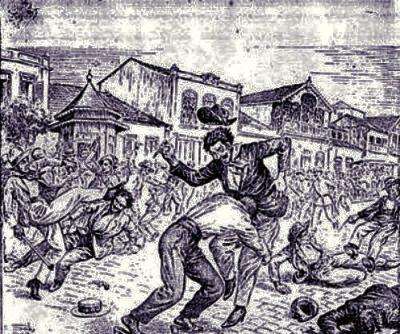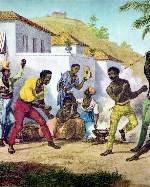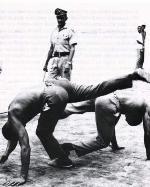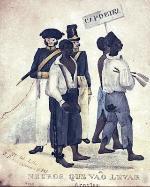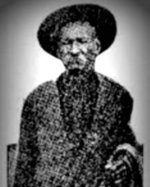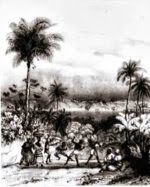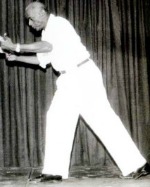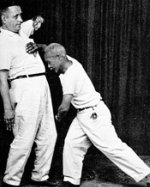Manduca da Praia – The Elegant Capoeira Fighter
Talk the Talk
The trained capoeirista has many moves available to him including three distinctive types of head-butts.
The Arpao de Cabeca begins by ducking under an attack and putting full body weight behind the attack.
The Escorumelo is similar but specifically targets under the chin and the Cabecada is more of a push or playful attack.
The Arpao de Cabeca begins by ducking under an attack and putting full body weight behind the attack.
The Escorumelo is similar but specifically targets under the chin and the Cabecada is more of a push or playful attack.
Walk the Walk
Although clemency was usually granted when a capoeira fighter submitted, this was not always the case and these fights could end with a serious injury to the loser and in some cases even death.
Manduca fought in many such battles and was undefeated despite fighting the best fighters Rio de Janeiro had to offer.
Manduca fought in many such battles and was undefeated despite fighting the best fighters Rio de Janeiro had to offer.
Capoeira Quote
Today a lot of capoeiristas are very arrogant, vain and these are negative aspects.
A good capoeirista is humble, polite and he knows that all the other capoeiristas are brothers and human beings.
~ Mestre Suassuna ~
A good capoeirista is humble, polite and he knows that all the other capoeiristas are brothers and human beings.
~ Mestre Suassuna ~
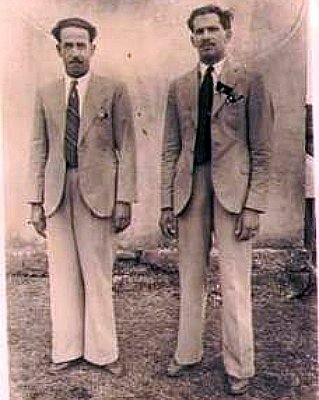 Mestre Manduca da Praia was a well-loved and respected capoeira fighter famed for his sense of style, his elegant persona and for being one of the best martial arts practitioners in late nineteenth-century Brazil. He is described as a tall man with a pointy beard and grey and copper-coloured hair that he covered with his trademark white beaver hat.
Mestre Manduca da Praia was a well-loved and respected capoeira fighter famed for his sense of style, his elegant persona and for being one of the best martial arts practitioners in late nineteenth-century Brazil. He is described as a tall man with a pointy beard and grey and copper-coloured hair that he covered with his trademark white beaver hat.A Legend in the History of Fighting
Both feared and respected in equal proportions, Manduca had extreme confidence in his abilities in the capoeira arts and stories of his battles with police and other capoeiristas circulated so much that they turned him into a legend in the history of fighting. Agile and very acrobatic, the Mestre was capable of fighting multiple opponents with his bare hands and feet but was also an expert at using weapons such as a knife or a wooden stick known as a petropolis.Manduca, like other Brazilian capoeira experts of the time was dignified and had an elegant manner in which he carried himself. However what really set him apart was his extraordinary ability to think on the spot, which allowed him to out-wit most opponents who faced him.
Although many who were prolific in the capoeira arts excelled in the criminal gangs, Mestre Manduca da Praia avoided this fate. Instead, he was a well-respected local businessman who gained a decent living from his fish counter on the market square. He also made money from bodyguard work, especially for politicians which made him connections that kept him out of jail despite being arrested twenty-seven times for fighting and practicing capoeira.
Capoeira Mestre Nascimento Grande. [Internet]. 2011. Live Capoeira. Available from: http://voices.yahoo.com/capoeira-mestre-nascimento-grande-8121954.html?cat=37 [Accessed November 30, 2012].
Great Birth. [Internet]. 2008. Grupo Senzala Celeiro De Bambas. Available from: http://www.senzala.org.br/historia/bibliografia/17-nascimento-grande.html [Accessed November 30, 2012].
Manduca da Praia history. [Internet]. 2012. Capoeira Wiki. Available from: http://capoeira.wikia.com/wiki/Manduca_da_Praia (Translated version). [Accessed November 30, 2012].
The Criminal Underworld and Brazilian Capoeira
In the nineteenth century, capoeira was synonymous with gangs and the criminal underworld as those who had taken the time and effort to learn martial arts tended to have an advantage over those who did not due to their fighting skills. As with many other world martial arts, the best capoeira fighters would challenge each other to no-holds-barred street fights, the winner being decided when one fighter could no longer continue, either due to knockout, injury or submission.Although many who were prolific in the capoeira arts excelled in the criminal gangs, Mestre Manduca da Praia avoided this fate. Instead, he was a well-respected local businessman who gained a decent living from his fish counter on the market square. He also made money from bodyguard work, especially for politicians which made him connections that kept him out of jail despite being arrested twenty-seven times for fighting and practicing capoeira.
Written by Andrew Griffiths – Last updated 18/07/2023. If you like
what you see, consider following the History of Fighting on social media.
Further Reading:
About Capoeira History. [Internet]. 2010. Origens Do Brasil. Available from: http://www.origensdobrasil.co.uk/history.php [Accessed November 30, 2012].Capoeira Mestre Nascimento Grande. [Internet]. 2011. Live Capoeira. Available from: http://voices.yahoo.com/capoeira-mestre-nascimento-grande-8121954.html?cat=37 [Accessed November 30, 2012].
Great Birth. [Internet]. 2008. Grupo Senzala Celeiro De Bambas. Available from: http://www.senzala.org.br/historia/bibliografia/17-nascimento-grande.html [Accessed November 30, 2012].
Manduca da Praia history. [Internet]. 2012. Capoeira Wiki. Available from: http://capoeira.wikia.com/wiki/Manduca_da_Praia (Translated version). [Accessed November 30, 2012].
More Capoeira History
Capoeira History Home
An overview of the history of capoeira from its early roots, its development by slaves in Brazil, how it flourished amongst criminals and its further development and legitimisation by Mestre Bimba in the early twentieth century.
An overview of the history of capoeira from its early roots, its development by slaves in Brazil, how it flourished amongst criminals and its further development and legitimisation by Mestre Bimba in the early twentieth century.
The Roots of Capoeira
The exact roots of capoeira are unknown and largely unstudied. This article explores the possible beginnings of capoeira history and looks at how and why it became a part of the culture amongst Brazilian slaves from the sixteenth century onward.
The exact roots of capoeira are unknown and largely unstudied. This article explores the possible beginnings of capoeira history and looks at how and why it became a part of the culture amongst Brazilian slaves from the sixteenth century onward.
Brazil’s Criminal Underworld
From the late 19th century, the criminal underworld of Brazil saw its numbers dramatically rise when slavery legally came to an end in 1888. Many skilled fighters became powerful and as many of them were capoeirista, the martial art became synonymous with criminal gangs.
From the late 19th century, the criminal underworld of Brazil saw its numbers dramatically rise when slavery legally came to an end in 1888. Many skilled fighters became powerful and as many of them were capoeirista, the martial art became synonymous with criminal gangs.
Jose Antonio do Nascimento
Jose Antonio do Nascimento was one of the best fighters of the nineteenth century. His skills earned him a fearsome reputation and his size and prowess earned him the nickname Nascimento Grande (Big Birth).
Jose Antonio do Nascimento was one of the best fighters of the nineteenth century. His skills earned him a fearsome reputation and his size and prowess earned him the nickname Nascimento Grande (Big Birth).
Mestre Besouro Manganga
Besouro Manganga was such a prolific capoeira fighter that people believed him to have magical powers (known as corpo fechado). His agility and nimbleness helped him avoid capture time and time again, and even when cornered by police, he would usually come out on top.
Besouro Manganga was such a prolific capoeira fighter that people believed him to have magical powers (known as corpo fechado). His agility and nimbleness helped him avoid capture time and time again, and even when cornered by police, he would usually come out on top.
Mestre Bimba
Mestre Bimba is important in capoeira history because of the role he played in legitimizing the art. By introducing a code of ethics, set training methods and a number of new techniques, he helped change capoeira from an illegal discipline associated with crime, to an iconic cultural pastime.
Mestre Bimba is important in capoeira history because of the role he played in legitimizing the art. By introducing a code of ethics, set training methods and a number of new techniques, he helped change capoeira from an illegal discipline associated with crime, to an iconic cultural pastime.
Angola Capoeira
The Angola style of capoeira is one of the two main systems of the art and was introduced in 1942 by Mestre Pastinha. Unlike the other style, Regional capoeira, it focuses the individual development of each capoeirista as opposed to practicing set sequences and training methods and is more akin to the type of capoeira practiced prior to the 20th century.
The Angola style of capoeira is one of the two main systems of the art and was introduced in 1942 by Mestre Pastinha. Unlike the other style, Regional capoeira, it focuses the individual development of each capoeirista as opposed to practicing set sequences and training methods and is more akin to the type of capoeira practiced prior to the 20th century.
The images on this site are believed to be in the public domain, however, if any mistakes have been made and your copyright or intellectual rights have been breeched, please contact andrew@articlesonhistory.com.

